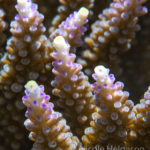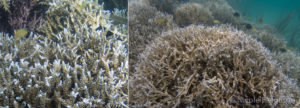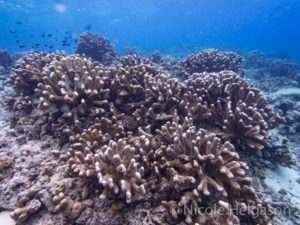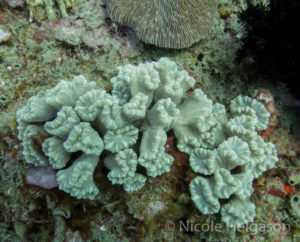Corals grow in several unique forms, but none are more recognizable than branching species. Coral branches can be long and dedicated or thick, robust fronds. But all branching corals have one thing in common — they create complex three-dimensional habitat, home to 25 percent of all tropical fish. The most abundant genus of branching corals is Acropora, with over 100 described species in the Indo-Pacific. If you are just learning to identify corals, Acropora is the best place to start.
When reading the scientific names of corals, the name starts with a genus, then a species. For example, Acropora milliepora — Acropora is the genus, milliepora is the species. The first step in coral identification is learning to recognize corals at the genus level. Once you have that mastered, you can narrow it down to species. In our introduction to branching corals of the Indo-Pacific below, there are eight common coral genera to help you get started.


Acropora
In our introduction to Indo-Pacific hard corals, we wrote about coral polyps and the hard calcium-carbonate skeleton they building around their bodies called a corallite. All hard-coral species have corallites, but Acropora corals have one larger, distinct, tubular corallite on the tip of each branch. This is called an axial corallite and is unique to Acropora.
To identify this coral, just look for the axial corallite. If the branch has uniform corallite sizes or multiple corallites on the branch tip you can confidently call it Acropora.

Anacropora
Not to be confused with Acropora, Anacropora branches are thin, between 3 to 15 mm or (.1 to .5 inches) in diameter. Branched areas can be flat at the tip but most often they taper to a thin point. Although the tip is a lighter color than the colony, don't be fooled — there is no corallite.
Anacropora has smooth branches with knobby, widely-spaced corallites. The branches are delicate, so be careful when approaching or photographing this species. Anacropora can grow in dense colonies or spaced-out branches. Anacropora is a relatively fast-growing species and often sprawls above the substrate, covering a large area.

Isopora
Isopora is a robust coral, easily identifiable in the Indo-Pacific. If you are just starting to learn coral identification, you shouldn't have a problem spotting this wide-spread coral species.
Branching colonies of Isopora form thick, flattened, upright blades that stretch to the surface. Some Isopora colonies grow in an encrusting form, but the most common is branching.
Isopora colonies are covered in smooth, rounded corallites, and the color can be pale brown to a creamy white or yellow. You will find this coral on shallow reefs and the crest of reef slopes down to 65 feet (20 m). There is only one species: Isopora palifera.

Pocillopora
Pocillopora is abundant in the Indo-Pacific; you'll find it from the shallowest to the deepest parts of the reef. There are almost 20 species of Pocillopora, but they all have the same characteristic bumpy branches, which can be densely packed or wide and spread out. Formation depends on the species and the flow conditions where you find it. Pocillopora's common name is cauliflower coral because of the short, lumpy branches.

Seriatopora
Seriatopora is a small, branching coral that has fuzzy polyps. The branches can have smooth branch tips or pointed branch tips. Identify this coral by looking at the placement of each polyp: in Seriatopora coral, all the polyps line up in a neat row or series. If you spot the polyps in a row, you've got a Seriatopora. This coral is often pink or yellow.

Montipora
Montipora is one of the most abundant corals with over 50 species in the Indo-Pacific. Montipora can be branching, encrusting, or form thin plates. At times you can even find branches going out of plates. You can identify Montipora via its small corallites, which are embedded in the surface of the coral. You'll often find them between ridges, although they lack a distinct corallite wall.
It can be easy to confuse Montipora and Porites coral as they have similar sunken corallites. The difference is in how easily you can see defined corallite walls. Montipora corallites are slightly smaller and less pronounced than Porites, with rough or less-obvious wall structure.

Porites
Just like Montipora, Porites coral can be branching, encrusting, or plating. Identify Porites corals by looking for small corallites that are sunken in the surface of the coral. The small corallites look like pores covering the surface of the colony, which is where we get the name "Porites."
Porites' corallites are well-defined with well-formed walls. Don't be discouraged if you're having a tough time separating Porites and Montipora corals. The more you start teasing these two genera apart, the easier it gets.

Caulastrea
This small coral features little, trumpet-shaped corallites. While it doesn't have large branches, each corallite forms a short stalk, which makes it a member of this category.
Each stalk can be few centimeters long and have one of two corallites on the end. The corallite at the end is around 2 cm (.5-inch) wide, depending on the species. Look closely to see some corallites that are pinched in the center like a figure eight. This is how a single corallite slowly splits in two, forming a second branch.
The post Introduction to Branching Corals of the Indo-Pacific appeared first on Scuba Diver Life.
from Scuba Diver Life https://ift.tt/2utUTNJ
No comments:
Post a Comment